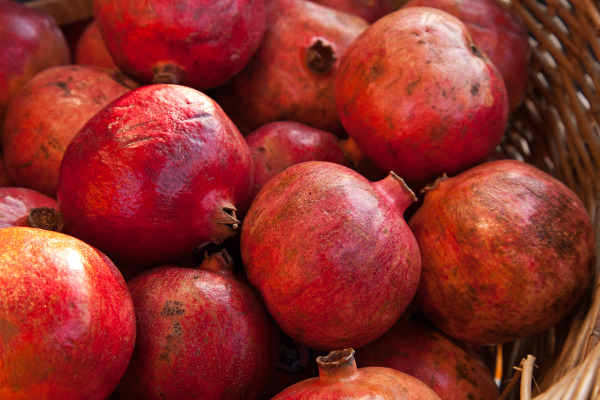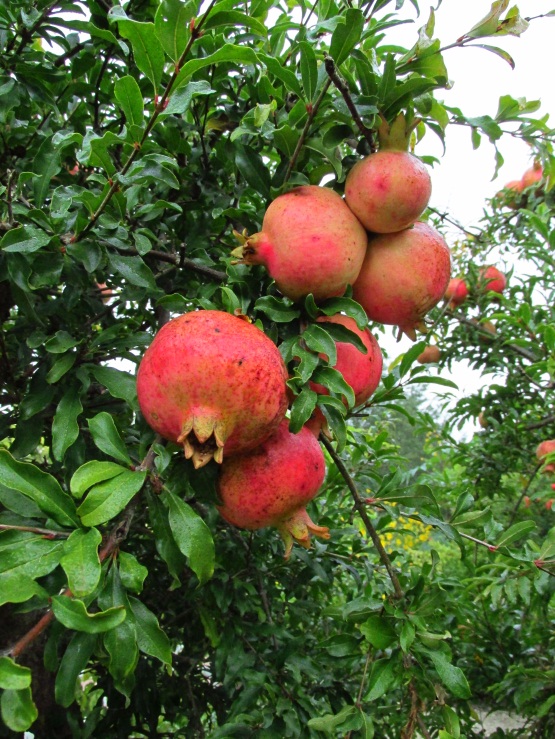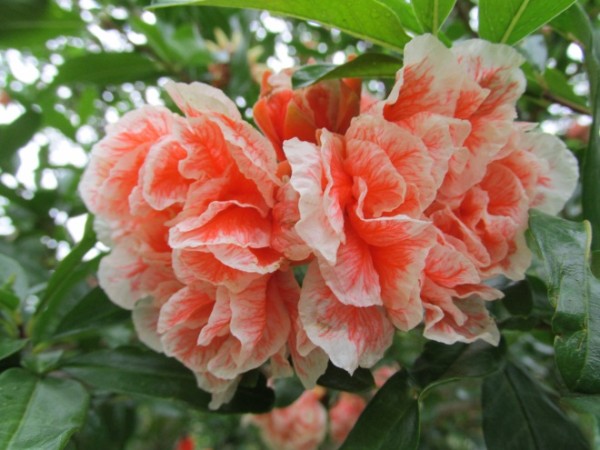 The pomegranates are now in their perfection.
The pomegranates are now in their perfection.

Pomegranate fruit
Many visitors to Williamsburg are surprised to see this exotic fruit in the garden, but the pomegranate has a long history in Virginia.
Pomegranates were first recorded in Virginia by Robert Beverley in 1705 and George Wythe of Williamsburg made a present of pomegranate trees to his pupil, Thomas Jefferson, in 1770.
We grow three varieties of the pomegranate.
The fruiting pomegranate is amongst the most ancient of all the culinary fruits originating in ancient Persia and cultivated throughout the Middle-Eastern region since ancient times. Pomegranates are illustrated in Egyptian tombs, described in the Babylonian Talmud and lamented by the Israelites in their flight from Egypt (Num. 11:15).

Ornamental pomegranate
We also grow an ornamental pomegranate. These showy specimens are grown solely for their doubled flowers as they produced no fruit and are thereby reliant upon the hand of man for their propagation.
While it is not clear when the first non-fruit bearing or ornamental pomegranates appeared they are well illustrated by the 16th century.

Dwarf pomegranate
Philip Miller recorded in The Gardeners Dictionary (1754): The double-flowering Kind is much more esteemed in this Country [England], for the sake of its large fine double Flowers, which are of a most beautiful scarlet Colour; and, if the Trees are supplied with Nourishment, will continue to produce Flowers for near three Months successively, which renders it one of the most valuable flowering Trees yet known.
We also grow a dwarf pomegranate in a clay pot. They are in every way a miniature version of the fruiting pomegranate.
They will grow no taller than three feet and flower from May to October, producing small fruit in the late summer and unlike many other aberrant’s of nature; will produce like offspring from the seed of the fruit.

Craig Bollenberg says
Mr. Greene, how is your pomegranate orchard doing since the hard winter of 2015? What did you do to restart the orchard?
Cindy Bowser says
I have had a dwarf pomegranate for two years and can never get it to bear any fruit. I do occasionally put a liquid miracle grow on it. Any suggestions? I live here in Williamsburg and really like your blogs.
My Dear Cindy,
I have often heard it said that life will teach one patience, I would observe that tending a garden is an even better instructor of this particular virtue. The dwarf pomegranate that I keep in a pot in my garden on the Duke of Gloucester Street first produced fruit in its third year. I would be cautious, however, of giving it too much fertilizer, particularly nitrogen, as this will often produce foliage at the expense of fruit. One of the pelletized fertilizers that release their agents slowly over a longer period of time is perhaps better suited to the pomegranate.
Yr. obedient servant,
Wesley Greene
Sara says
An interesting post, I always enjoy these postings. What varieties of pomegranates do you grow though? I have struggled to find much information on historic pomegranates and the development of individual varieties. What was the basis of your selection? I imagine household inventories might be very useful for that kind of thing. Thankyou for your work.
Sara
Dear Sara,
The pomegranates in my garden were originally obtained from cuttings taken from some old trees at the Governor’s Palace. While I cannot be certain what variety they are they are almost certainly ‘Wonderful’ which has long been the most common variety amongst commercial and private growers. It originated in Florida in 1896 and until recently was the most common pomegranate variety in California, where most of our pomegranates come from. ‘Grenada’ is starting to replace Wonderful in commercial groves for its better color and it does not have quite the tendency to split when ripe which is the major drawback to ‘Wonderful.’ 18th century authors seldom give meaningful cultivar names. For example, Philip Miller, author of the Gardeners Dictionary which was the most widely read horticultural manual of the 18th century lists “The common Pomgranate, The sweet Pomgranate, The wild Pomgranate, The double-flower’d Pomgranate and The American dwarf Pomgranate.” At Colonial Williamsburg we use descriptions such as this to arrive at the best facsimile for varieties that are often extinct. ‘Wonderful’ is the oldest variety I have been able to find and I am confident would be recognizable to the 18th century gardener.
Cordially,
Wesley Greene
Craig Bollenberg says
Mr. Greene, where can I find your pomegrante trees in Williamsburg? Is there a street address I can use? Thank you.
Dear Craig,
Unfortunately I have no street address but the orchard where my pomegranates are located are very easy to find as it is directly across the street from the old Bruton Parish Church on the Duke of Gloucester Street in Williamsburg. The Duke of Gloucester Street is closed to modern forms of conveyance so you must park either at the Visitor’s Center of Colonial Williamsburg or one of the parking lots on the west end of town and walk or ride a bus from there.
Cordially,
Wesley Greene
An interesting topic would be edible landscapes. Which I would believe might have been practiced in the past since food sources were so important. What pomegranate would be good to purchase for the foothills of North Carolina zone 7. Thanks for your interesting articles.
Dearest Joan,
The most common colonial landscape was an edible landscape as the kitchen garden was as much a sign of prestige as it was of sustenance. The diet in colonial America was heavily weighted towards grain and meat. In Virginia ninety percent of the population subsisted on a monotonous diet that was sixty to seventy percent corn, cowpeas and dried beans. The more affluent had a diet that was heavily dependent on meat dishes. Garden vegetables were a small part of the diet and many were considered luxury items so household gardens in the 18th century, like household gardens in the 21st century, provided luxuries rather than staples. The pomegranate is hardy in zone 7 so you should be able to grow it in North Carolina. We grow a variety called ‘Wonderful’ which was developed in Florida late in the 19th century and remains the most common variety available today. While pomegranates are easy to grow, it is often difficult to ripen quality fruit as they need to mature in a dry climate. This year has been one of the better seasons for pomegranates as it has been a relatively dry fall. When it turns wet the fruit will split before they are fully ripe and never develop the full sweetness of a pomegranate raised in its native desert clime.
Cordially yours,
Wesley Greene